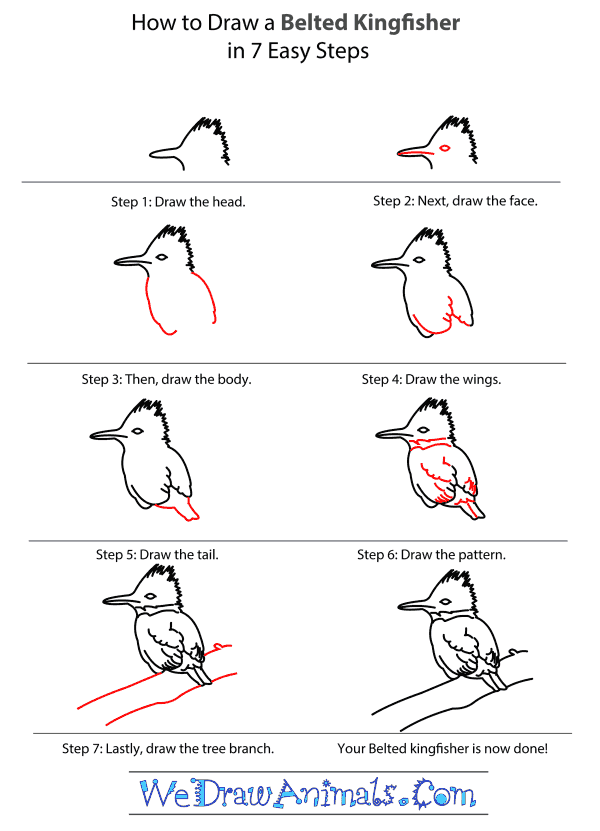In this quick tutorial you'll learn how to draw a Belted Kingfisher in 7 easy steps - great for kids and novice artists.
The images above represent how your finished drawing is going to look and the steps involved.
Below are the individual steps - you can click on each one for a High Resolution printable PDF version.
At the bottom you can read some interesting facts about the Belted Kingfisher.
Make sure you also check out any of the hundreds of drawing tutorials grouped by category.
How to Draw a Belted Kingfisher - Step-by-Step Tutorial
Step 1: Draw the head. There is a short sideways "V" that makes the beak. From the top of the beak line draw a curved jagged line up and then down to the right.
Step 2: Next draw a straight line along the beak to make the mouth. At the end of that line draw a circle to make the eye.
Step 3: Continue the bottom beak line down to make the belly line. Curve it down and slightly to the right. From the right side of the head line draw another curved line down and curve it to the left at the bottom.
Step 4: Now draw the wings. Draw two round "U" shapes between the belly and back lines. Add small bumps to make the feather lines.
Step 5: From the bottom of the two wing lines draw the tail. The two lines come together to make a squarish tip.
Step 6: Make the feather markings. Draw squiggly lines along the wings, tail and head.
Step 7: Lastly, draw a line at the bottom of the body line. Draw another line under the first line. This is the tree branch that the kingfisher is perched on.
Interesting Facts about the BELTED KINGFISHER
The Belted Kingfisher is a member of the bird group and the scientific term for them is Megaceryle alcyon. This species gets its name from the brownish orange band across its belly, and the way that they dive head first into the water after a fish – the most efficient fishing method. It is mostly a white bird with a blue head and body. They are a thick and medium size, with long feathers on the head, and a long thick beak.
Did you know?
- This animal was first documented in 1758.
- There are Canadian dollar bills that have depicted this animal since 1986.
- The body is more than 1 foot long.
- Their wingspan is almost 2 feet wide.
- This bird weighs almost .5 pounds.
They live at habitats of water in North America, where they exhibit seasonal migration. Some individuals do not pursue warmer climates in the Winter, and others migrate too far, such as at remote islands. Nests are burrows made underground by the water, with babies above the entrance level so that they do not drown if the water rises. These animals have a low population amount, but are considered to be the least concern for the possibility of extinction.








